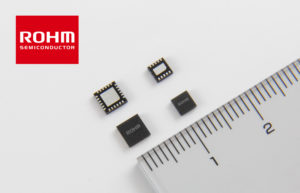 ROHM today announced the availability of a buck-boost power supply chipset that provides the lowest current consumption in the industry along with stable performance (transient response characteristics) in automotive ECUs (Electronic Control Units) for cluster panels and gateways used in start-stop vehicle systems.
ROHM today announced the availability of a buck-boost power supply chipset that provides the lowest current consumption in the industry along with stable performance (transient response characteristics) in automotive ECUs (Electronic Control Units) for cluster panels and gateways used in start-stop vehicle systems.
The chipset integrates a buck DC/DC converter with boost functionality (BD8P250MUF-C) and a dedicated boost IC (BD90302NUF-C). The primary chip (BD8P250MUF-C) utilizes ROHM’s novel buck-boost control technology, dubbed Quick Buck Booster, that enables configuration of a buck-boost power supply without degrading buck power supply characteristics by simply adding the dedicated BD90302NUF-C boost IC to the subsequent stage.
The result is an industry-best no-load current consumption of 8uA and ±100mV output voltage fluctuation utilizing an output capacitance 44uF (70% less current consumption and 50% less output capacitance vs conventional products), contributing to improved stability and energy savings in applications where significant input voltage drops occur in a short period of time, such as start-stop vehicle systems. In addition, Quick Buck Booster technology allows for a common board design that integrates both buck-boost and buck power supply topologies along with the requisite peripheral components and noise countermeasures, reducing development time and labor by 50% compared to conventional methods requiring separate buck-boost and buck power supply boards.
In recent years, to meet the greater environmental performance demanded in the automotive sector, the number of vehicles equipped with start-stop functionality that turns the engine/motor OFF while idle has grown significantly. In these systems, a buck-boost power supply is required to prevent malfunctions due to low battery voltage during idling and battery fluctuations (cranking) immediately after start-stop operation, but conventional products are problematic from the standpoint of current consumption and responsiveness, increasing the demand for an improved solution as the number of stop-start vehicles continues to rise.
In response, ROHM leveraged analog design technology and power system processes to develop groundbreaking solutions for the automotive market, such as products that integrate Nano Pulse Control high speed pulse control technology. This time, ROHM developed a buck-boost power supply chipset utilizing proprietary automotive technology centered on Quick Buck Booster control that overcomes the issues related to start-stop systems. And going forward, ROHM will continue to support the evolution of vehicles by developing products and technologies that contribute to greater power savings and system optimization.
The ICs available now in sample quantities and January 2019 in OEM quantities.


Leave a Reply